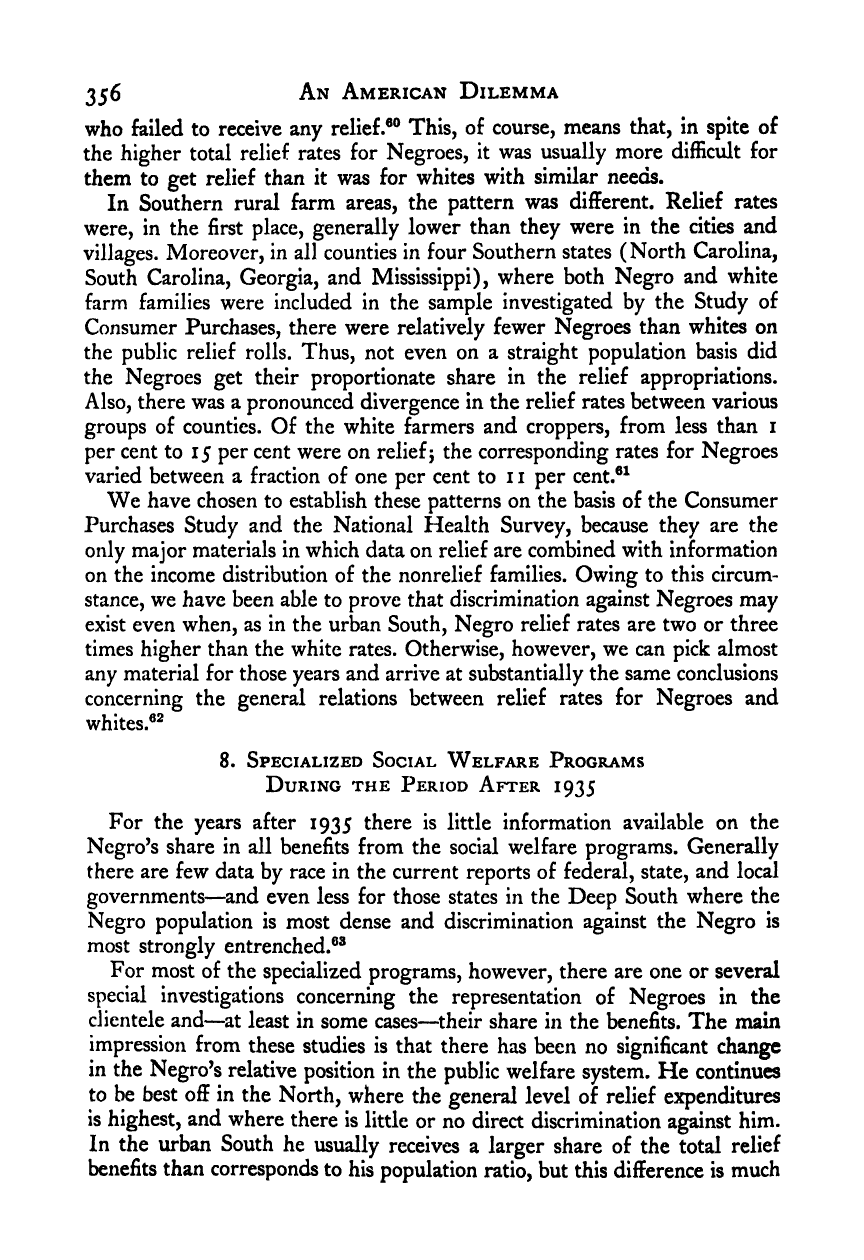Note: Gunnar Myrdal died in 1987, less than 70 years ago. Therefore, this work is protected by copyright, restricting your legal rights to reproduce it. However, you are welcome to view it on screen, as you do now. Read more about copyright.
Full resolution (TIFF) - On this page / på denna sida - IV. Economics - 15. The Negro in the Public Economy - 7. Social Security and Public Assistance - 8. Specialized Social Welfare Programs during the Period After 1935

<< prev. page << föreg. sida << >> nästa sida >> next page >>
Below is the raw OCR text
from the above scanned image.
Do you see an error? Proofread the page now!
Här nedan syns maskintolkade texten från faksimilbilden ovan.
Ser du något fel? Korrekturläs sidan nu!
This page has never been proofread. / Denna sida har aldrig korrekturlästs.
356 An American Dilemma
who failed to receive any relief.®® This, of course, means that, in spite of
the higher total relief rates for Negroes, it was usually more difficult for
them to get relief than it was for whites with similar needs.
In Southern rural farm areas, the pattern was different. Relief rates
were, in the first place, generally lower than they were in the cities and
villages. Moreover, in all counties in four Southern states (North Carolina,
South Carolina, Georgia, and Mississippi), where both Negro and white
farm families were included in the sample investigated by the Study of
Consumer Purchases, there were relatively fewer Negroes than whites on
the public relief rolls. Thus, not even on a straight population basis did
the Negroes get their proportionate share in the relief appropriations.
Also, there was a pronounced divergence in the relief rates between various
groups of counties. Of the white farmers and croppers, from less than i
per cent to 15 per cent were on relief j
the corresponding rates for Negroes
varied between a fraction of one per cent to 1
1
per cent.®^
We have chosen to establish these patterns on the basis of the Consumer
Purchases Study and the National Health Survey, because they are the
only major materials in which data on relief are combined with information
on the income distribution of the nonrelief families. Owing to this circum-
stance, we have been able to prove that discrimination against Negroes may
exist even when, as in the urban South, Negro relief rates are two or three
times higher than the white rates. Otherwise, however, we can pick almost
any material for those years and arrive at substantially the same conclusions
concerning the general relations between relief rates for Negroes and
whites.®^
8. Specialized Social Welfare Programs
During the Period After 1935
For the years after 1935 there is little information available on the
Negro’s share in all benefits from the social welfare programs. Generally
there are few data by race in the current reports of federal, state, and local
governments—and even less for those states in the Deep South where the
Negro population is most dense and discrimination against the Negro is
most strongly entrenched.®®
For most of the specialized programs, however, there are one or several
special investigations concerning the representation of Negroes in the
clientele and—at least in some cases—^their share in the benefits. The main
impression from these studies is that there has been no significant change
in the Negro’s relative position in the public welfare system. He continues
to be best off in the North, where the general level of relief expenditures
is highest, and where there is little or no direct discrimination against him.
In the urban South he usually receives a larger share of the total relief
benefits than corresponds to his population ratio, but this difference is much
<< prev. page << föreg. sida << >> nästa sida >> next page >>